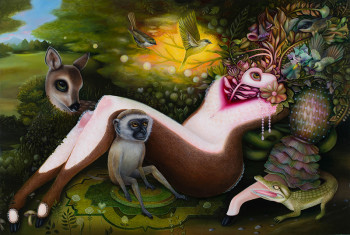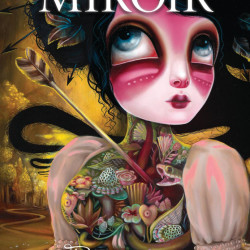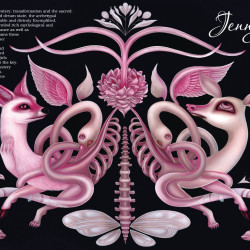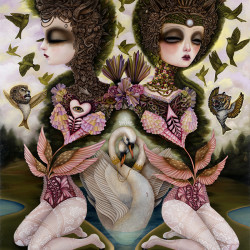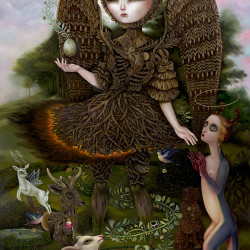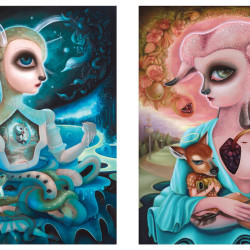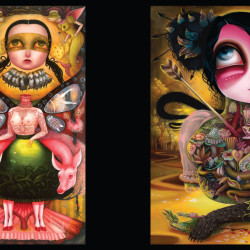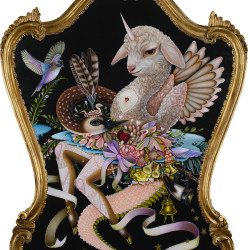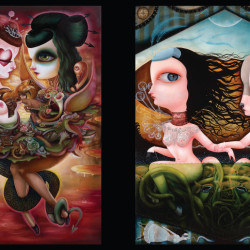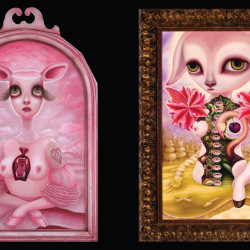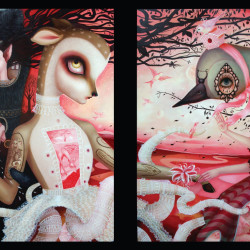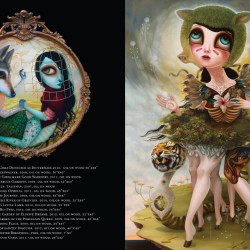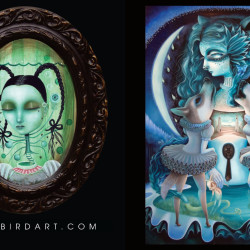Q: The first thing that strikes me when I look at your art is the beautiful, deeply emotive and exaggerated eyes. What compels you to create them in this way?
A: Well, they say the eyes are the windows to the soul, and I guess besides really liking to paint them, the exaggeration of the eye is partially to draw the viewer first to her face for a recognition of the human element that connects the viewer to this creature that though fantastical or unusual echoes, their likeness, and hopefully helps them step into this landscape in an accessible way.
Q: The chests are gaping open, revealing what is usually unseen. What is this an indication of? Does this mean you feel that we as humans are not what we seem?
A: I don’t know if Id say that we are not what we seem but we humans are very complex creatures and all of those, sometimes dueling, parts of oneself are true, sometimes we are exactly what we seem, like it or not. In my work, I am trying to integrate all the varied parts of human nature, and almost exclusively the work that I create is revolved around the heart space and very often all the elements of the painting are either growing out of, retreating to or attacking that space.
Q: There seems to be a sense of tender melancholy in your characters. Why?
A: I try to capture a sliver state in between wonder melancholy and a dream. I like the character to hover in that space, it feels less limiting to me then if I were to depict overt joy or sorrow. I like to find a place in the middle, a contemplative place so that the feeling in the work is more mutable, and can be seen in different ways depending on how I feel.
Q: Why are all of your characters all female?
A: I get this question a lot, mostly from my male friends. My work is pretty personal, and since I’m female the main character I see through my eyes so she is always female, if she takes on male characteristics they are typically represented by an animal. I have a lot of male collectors so I know that there is something in there for a guy to connect to, I’m exploring in the murky depths of the soul and I hope that there is something in there for anyone who feels drawn to the work to find and see as a reflection of themselves.
Q: When did you begin painting as a serious artist?
A: Since I ‘decided’ as a teen I was an artist I’ve felt serious about it, I do have a tendency to take things too seriously..lol.. but when I was in art school is when I knew that I ‘was’ a serious artist.
Q: How and when did you know this was your path?
A: When I was a teen, I realized I truly enjoyed expressing myself in a creative way and I decided I wanted to ‘become’ an artist. It was so frustrating in high school, I remember crying the first Semester I couldn’t get in because art class was full of jocks that took it for an ‘easy’ elective…come to find out the next semester, the teacher was also the baseball coach and couldn’t draw to save his life… lol.
Q: What style did you begin painting in, and how has it evolved into what it is today?
A: Wow, well ‘began’ is a long time ago. I’ll skip the pre art school formative work though I started painting when I was around 13. In art school I was trying to express myself in my work and it was overtly personal. I was also discovering that I liked to work in a large format. In school I created really expressive paintings. Though there were still fairy tale narratives hidden in there, my work was really loose with big swaths of color, and I loved painting flesh… Over time my style of putting down paint has refined and continued to evolve and the narrative has become more clear and deliberate while still working to maintain mystery. I’m always pushing myself so I’m sure my work will continue to evolve slowly over time.
Q: A common theme in your paintings is a division, often represented as liquid, blood or water, treetops or earth itself, that separate the human elements with the creature elements. Can you explain what this means to you?
A: I’m interested exploring what it means to be a human sharing this tiny planet with all of the other creatures and elements. Through my use of the flora and fauna integrated with the main character, I’m speaking to the connection and often divisions between all living things. I’m exploring human nature through the eyes and ears (literally) of animals.
The liquid when blood, often represents life or wearing her heart on her sleeve. When water, a dream state and suspended animation. I’m really in love with these floating ponds around my characters – it’s like they are existing in their own little world within the world of the painting. Sometimes she isn’t aware of her own hidden parts as they change once beneath the fluid surface. This is also a way to illustrate duality.
Q: Anthropomorphic art is often blatantly depicted as an animal head on an elaborately costumed human body. Although this is sometimes the case with your work, frequently your characters are more of a morphing of the two, a subtler approach from which emerges entirely new creatures. Where do these visions come from?
A: Sometimes my paintings come to me in dreams, not whole and intact and wrapped up with a bow (unfortunately) but in pinhole views and momentary flashes… But there is always rhyme and reason to the way the characters are blended together with the natural world elements.
Hybrids are a major aspect to the work I create. I see every facet of nature, human nature and flora and fauna of the natural world as interconnected. So in my work, all these elements visually manifest themselves in a connected way.
Q: As best as you can, please describe the reactions you get when viewers see your work for the first time.
A: Of course many people that I meet at opening are very kind and have lovely things to say to me about my work, but I wouldn’t presume to know what the general public or art community feels about it. Art is such a personal experience so to answer to how a body of people feel would seem presumptuous and potentially inaccurate on my part.
Q: How does that feedback feel to you?
A: When I hear positive feedback I feel happy, grateful and relieved as well, you know, I spend so much time alone in my studio that its hard to maintain perspective on the work sometimes so it can be quite scary revealing new work.
Q: How do you hope your work will effect or move others, or is this something you consider at all?
A: I do consider this. It took me several years after graduating art school to get up the nerve to show my work because: A) I’m a perfectionist but mainly because: B) I’m a chicken. When I finally did show my work and met people that weren’t peers or family or friends who had a strong connection to it, I finally understood that a major part in the life of a work of art happens after it leaves the studio and goes out into the world. I know what I do isn’t for everyone and this is ok with me, and in fact makes it more special for the people that do connect with it as far as I’m concerned. But while I will always feel the work is mine, when someone loves a piece and buys it and takes it to live with them it takes on new meaning as it is reflected though new eyes. Everyone comes to a work of art with all of their past experiences, loves and wounds in their pocket, and what work they are drawn to and how those images or brush strokes or colors affect them is there’s alone. This is also why I am careful not to reveal too much about what any individual piece means to me as I don’t want to limit what it can mean to someone else.
Q: What is the nature of the duality and mirror imaging in so much of your art?
A: Duality is a huge aspect of my work. I think it’s hard to escape it when you see the cycle of life and death in humans animals and nature, one is always attached to the other. I don’t think you can experience true love without knowing what it feel like to feel alone. All of the emotions we experience, we experience all the richer whether they be joy or sorrow or fury or love, fear or harmony, because we have felt the opposite… and so duality reveals itself over and over in my paintings. I want to be the ‘good’ character, the innocent one, but I’m also the other girl the one with her hand hidden behind her back or under her skirt with a secret or darker nature.
Q: Though I find your art beautiful and intriguing, some may find it a little disturbing. Is there a therapeutic aspect to your work, an underlying current that compels you to use symbols like tears and arrows?
A: Yes, most definitely. When you do the kind of work that I do, there is a bit of personal bloodletting that goes hand in hand with the creation of the work.
My work is very personal to me, which took me a long time for me to be ok with; Somehow that seemed weak and I wanted to ‘compete’ with the male artists. There are many many masterful strong male painters out there but I finally realized that the strength of my work is in the ‘Heart ‘of it, so I’ve come to appreciate that, and be mindful to speak my truth in my work. And sometimes that truth is unsettling.
Q: My interpretation of the the eyes is that they indicate intuiveness and insighfulness, the arrows: vulnerability, while bared teeth predators seem to indicate power and ferocity… Am I close?
A: Yes, I’d say those interpretations are accurate. The only thing to remember about my work is that the characters interchange a lot of those roles.
Q: What is your artistic background? Did you study formally?
A: I received my BFA from the San Francisco Art Institute.
Q: You have had a book published. Was that a goal for you?
A: I have a beautiful catalog of my Creatures of Saintly Disguise show published, but not a comprehensive book of my work yet, so I still have that as a major goal.
Q: As a child, what kind of effect did fairy tales have on you?
A: I loved fairy tales of course, I can’t imagine a child that didn’t. But what was even better was to read the real fairy tales, the unDisneyfied versions, once I grew up.
Q: Were you exposed to fine art at a young age?
A: When I was little we had a family friend that was an artist, he had a regular job as a postman but his house was filled with tons of his crazy art. It kind of scared me at the time. I’d love to see it now and see what it was really like. But I was more exposed to crafts than fine art as a child – my mom was an occasional painter and made crafts and things a lot. Actually, my first box of oil paints were her old ones she hadn’t used in years that she gave me when I was around 14 I think.
Q: What is the feeling you have as you are about to begin a new painting?
A: Excitement, anticipation and trepidation… but mostly excitement.
Q: What is the feeling you have as you complete a painting?
A: Satisfaction and Relief. I go through so many ups and down within the course of working on a major painting that by the end I need a little time apart before I can fall back in love with the piece.
Q: When and why did you begin creating the dolls?
A: I made dolls and sculpted creatures as a kid with my best friend and we would sell our little creations at the town fair, so the doll making thing goes back a ways. When I was in art school I started making weird sexual organ like soft sculpture art pieces and rabbit dolls but these things were always for myself and never shown in galleries or sold. Around 2000 I designed a series of dolls called ‘Sideshow Sweeties.” They were a simple style painted cloth doll, all the individual characters had a poem that went with them; my idea was to ‘mass produce’ them but after making ten of each I was done and they became just a ‘limited edition’. I decided I only wanted to make one of a kinds after that and would make a handful or more every year to include in shows of my paintings. I liked the idea of taking a character out of the world of the painting and making her a ‘real girl’.
Q: Is there a spiritual or religious significance to your paintings?
A: I’m not a religious person, but I consider myself a spiritual person and I see my paintings as little markers on this life journey for me, and within the work I try to explore mystery and the veil between life and death. So in that way, they do carry spiritual significance for me personally.
Q: Where would you like to see the direction of your art or career go next?
A: I see my work as this mysterious giant flower that keeps unfolding and I always look forward to what surprises lay beneath the next layer of petals.



